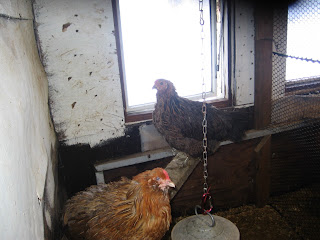Before commercial production, it used to be that every early American farm kept a laying flock. The old, weak, lazy layers and young roosters were culled and made their way to the stew pot or family table, and the rest were kept for eggs. I’m not sure anyone keeps a flock this way anymore, the people we know who have raised chickens either keep them for eggs, or raise the commercial Cornish Cross breed for meat, or both, but I don’t know anyone who raises their flock in the “old fashioned way”.
Last year we started keeping chickens. We have 18 hens and 1 rooster, and have several different breeds, all dual purpose, that we keep for eggs. We have Barred Rock, Buff Orpington, Ameraucana, and Australorp. Our rooster is a Barred Rock, chosen because they are supposed to be docile and easy to get along with, which I can confirm he is. Anyone who grew up terrorized by a mean and aggressive rooster will understand why I made my choice based on personality. I wanted all heritage breeds, but the pretty blue eggs of the Ameraucana won me over, so we got a few, and I’m really glad we did. All our breeds handle cold weather, and confinement well, although the barred rock rooster has a large comb which can get frost bite if allowed to get too cold. This is not a problem for us because we keep their housing above freezing year round. They are not known to be good foragers, but they do quite well I think. They also handle being shut in their coop for the winter, and have continued to lay all winter with some artificial lighting. I’ll write more about their housing in a later post.
Initially we planned on eating a few to see if we liked them well enough to raise them the “old fashioned way”. However, after getting our Cornish Cross and turkeys in the freezer, we never got around to it. From my research they grow slower and smaller, have a tougher texture, but more intense “chicken” flavor. We, like most Americans our age, have eaten only the commercial breed of chickens, for most of our lives. We have grown the Cornish Cross, and I’ll write more about that experience later, for now I’ll just say I can’t stand growing them and am looking for more natural alternatives. We bought a simple table top incubator; it has a fan, but not a digital thermometer or turner. We separated our Barred Rock and Ameraucana’s from the other two breeds, and are starting with those two first. I wanted to have an idea of how each breed did, so this was the only way I could figure out who laid what. I’ll talk more about our collection process and will make regular blog updates on our progress.
Enjoying the return of the warm sun
I have some questions for those of you out there who keep chickens. Do any of you keep dual purpose breeds for meat as well as eggs? Would anyone mind sharing their process? To what age to you raise them? How large do your birds get? Does anyone caponize their roosters?








